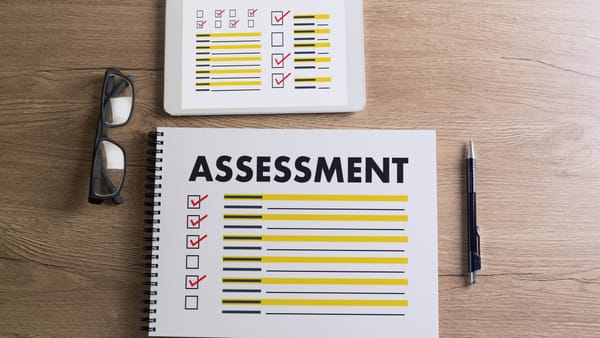The Key Concepts and Principles of Formative Assessment
Formative assessment principles form the foundation of effective teaching—discover how validity, reliability, and transparency create meaningful learning experiences.
Formative assessment principles form the foundation of effective teaching—discover how validity, reliability, and transparency create meaningful learning experiences.

Formative assessment principles represent the cornerstone of modern educational practice. Rather than functioning as isolated checkpoints, formative assessment principles work together as a dynamic framework that shapes learners' educational journeys in real time. As educators and trainers prepare learners for an increasingly complex and rapidly evolving world, understanding these key principles has never been more critical to success.
Formative assessment principles guide how educators collect evidence, make judgements, and provide feedback that drives immediate improvement. They ensure consistency, fairness, and authenticity across all learning environments—from traditional classrooms to online platforms and workplace training programmes.
At its heart, formative assessment operates as a continuous process of professional judgment. Educators evaluate learners' knowledge, skills, and competencies against clearly predetermined criteria specifically designed to guide improvement rather than merely assign grades.
This approach transcends simple mark-giving. Formative assessment principles require evaluating each learner's progress in relation to specific, measurable learning outcomes. The purpose is straightforward: provide timely, actionable feedback that enables learners to take ownership of their development.
The evidence gathered to support formative assessment judgements comes from diverse sources. Educators might use:
All this evidence is then measured against criteria derived from learning objectives or industry standards. However, the critical emphasis lies on identifying both strengths and specific areas for growth rather than simply recording a final score.
Formative assessment principles create a cyclical process. It begins with establishing transparent learning objectives, continues through systematic evidence collection and evaluation, and involves making informed judgements that directly inform immediate adjustments to teaching strategies and learning activities. This continuous cycle of improvement helps learners develop genuine competence, step by measurable step.
Two fundamental principles underpin all practical formative assessments: validity and reliability. These principles ensure that assessments accurately measure progress and consistently do so across different contexts, thereby supporting meaningful and dependable feedback.
Validity: Measuring What Actually Matters
Validity refers to the extent to which a formative assessment genuinely measures what it intends to measure. A valid formative tool accurately reflects the specific knowledge, skills, or competencies being developed within the curriculum or training programme.
Consider a practical example: if the learning objective focuses on developing learners' ability to write persuasive essays, validity demands that the assessment involve drafting and revising complete essays, perhaps with peer feedback. Multiple-choice questions about persuasive writing theory, whilst easier to mark, would not constitute a valid measure of actual compelling writing ability.
Similarly, if assessing clinical skills in nursing, validity requires practical demonstration with real or simulated patients rather than written descriptions of procedures. The assessment method must authentically replicate the real-world context where these skills will be applied.
Strong validity ensures that feedback genuinely reflects learner capabilities and that improvement efforts target the right areas.
Reliability: Ensuring Consistency and Dependability
Reliability concerns the consistency of assessment results. A reliable formative assessment yields similar outcomes when repeated under comparable conditions or when marked by different assessors. This principle minimises unwanted variations caused by timing fluctuations, slight differences in question phrasing, or individual assessor preferences.
For example, if two teachers assess the same portfolio using agreed criteria, reliability demands that they reach reasonably similar conclusions. If one teacher awards significantly higher marks than another for identical work, the assessment lacks reliability, making the feedback an unreliable basis for improvement.
Reliability also means that a learner's results should remain consistent if they complete the same assessment twice within a short timeframe, assuming their capability hasn't changed. This consistency allows learners, educators, and stakeholders to trust the feedback as an accurate representation of progress.
Building reliability requires clear assessment criteria, thorough assessor training, and systematic quality assurance processes.
Why Both Matter Together
Validity and reliability work in tandem. An assessment might be reliable but invalid—consistently measuring the wrong thing. Conversely, an assessment might be valid but unreliable—measuring the right thing inconsistently. Practical formative assessment requires both qualities operating together. Without them, the process fails to offer an accurate and dependable snapshot of learner progress, thereby undermining its fundamental role in fostering genuine development.
Evidence forms the absolute foundation of formative assessment principles. High-quality evidence directly informs judgments about learner progress and subsequently shapes the feedback provided.
Authentic evidence might include:
The quality of evidence gathered determines the quality of subsequent judgements. Assessors must deliberately ensure that the evidence collected possesses three critical characteristics:
Authenticity ensures genuine representation. The evidence must genuinely represent the learner's own work and capability. Plagiarised work, heavily assisted responses, or copied answers do not provide authentic evidence of what the learner can actually do. Authentic evidence confirms that improvements reflect genuine learning rather than external support masking knowledge gaps.
Sufficiency provides comprehensive coverage. Enough evidence must be gathered to cover relevant aspects of learner progress comprehensively. A single quiz response, for instance, offers insufficient evidence to judge overall competence in complex skills. Multiple evidence sources collected over time paint a more complete and reliable picture.
Currency ensures relevance to current ability. Evidence must reflect the learner's present skills, fundamental in fast-evolving fields where knowledge becomes outdated rapidly. Assessment evidence collected months ago may not accurately represent current capability, especially if learners have received significant new input since then.
These three qualities enable educators to make sound, defensible decisions about learner progress and to provide feedback that genuinely supports next steps in learning.
Objectivity and fairness are essential ethical principles that must underpin all formative assessment practice. These principles build trust, ensure integrity, and support learner confidence in the assessment process.
Objectivity: Basing Judgements on Evidence Alone
Objectivity means basing all judgements solely on evidence, remaining completely free from personal biases, preconceptions, or prior assumptions about the learner. Subjective judgments influenced by factors such as the learner's personality, previous performance, or demographic characteristics undermine fairness and validity.
For instance, an educator might unconsciously expect higher achievement from learners they perceive as "naturally bright," potentially interpreting ambiguous evidence more favourably for these learners. This bias—even if unintentional—compromises objectivity and leads to inequitable feedback.
Building objectivity requires educators to:
Fairness: Creating Equal Opportunity
Fairness ensures all learners have genuinely equal chances to demonstrate their progress, knowledge, and capabilities. This principle extends far beyond treating everyone identically—it requires recognising and accommodating different needs.
Fair assessment practices include:
Within formative assessment contexts, fairness proves particularly powerful because ongoing adjustments can address inequalities early, preventing disparities from accumulating over time.
Upholding objectivity and fairness builds trust among learners, ensures judgments focus on genuine abilities, and maintains the integrity of the learning process for learners, employers, and all stakeholders.
Transparency in formative assessment empowers learners by clarifying expectations, methods, and the reasoning behind assessment decisions. This principle substantially boosts learner engagement and supports self-directed learning.
When educators maintain transparent practices, they actively communicate:
With this clarity and understanding, learners can effectively:
Transparency reduces assessment anxiety, enhances accuracy in learner demonstrations (as they understand what's expected), and supports natural justice by enabling learners to understand and, where appropriate, challenge assessment decisions.
Transparent formative assessment creates a partnership between educators and learners—both working towards clear, understood objectives rather than educators making mysterious judgments in isolation.
Whilst these concepts and principles can be examined separately for analytical purposes, in actual educational practice, they interconnect seamlessly to create a truly holistic approach to supporting learner growth.
A practical example illustrates this integration: An educator teaching business communication might establish a transparent learning outcome ("Learners will write professional emails that achieve their intended purpose"). The educator ensures validity by requiring actual email drafting rather than theory tests, and builds reliability through agreed criteria applied consistently. Gathering sufficient, current, and authentic evidence from multiple email drafts over several weeks ensures judgements reflect genuine capability. Transparent communication of criteria empowers learners to self-assess, whilst objectivity and fairness principles ensure all learners—regardless of background or learning style—have equal opportunity to demonstrate capability.
This integrated approach transforms formative assessment from a compliance task into a powerful driver of genuine learning and development.
Educators must adapt formative assessment principles as educational landscapes evolve. Emerging technologies including online learning platforms, artificial intelligence tools, and new micro-credentials present both opportunities and challenges.
Adapting formative assessment principles to these contexts requires:
By thoughtfully embracing and adapting these principles, formative assessment can continue to enhance individual learning journeys whilst upholding the enduring value of meaningful qualifications and demonstrated capability.
1. What is the difference between formative and summative assessment?
Formative assessment focuses on providing ongoing feedback to guide improvement during the learning process. It helps educators and learners identify progress, celebrate strengths, and address gaps in real time. Summative assessment, by contrast, occurs at the end of a learning period and aims to measure overall achievement—think final exams or end-of-unit tests. Whilst summative assessment answers "what has been achieved?", formative assessment answers "how can we improve?" Both serve essential but distinct purposes.
2. How often should educators use formative assessment?
Effective formative assessment operates continuously throughout learning programmes rather than at fixed intervals. This might mean daily observations in classroom settings, regular quiz reviews, weekly portfolio updates, or ongoing practical demonstrations. The frequency depends on learner needs, subject complexity, and available resources. The key principle is that feedback occurs frequently enough to enable learners to adjust their approach and consolidate new understanding before moving forward.
3. Can formative assessment principles apply to online learning environments?
Absolutely. Formative assessment principles translate effectively to online contexts through varied approaches: discussion forum participation, digital portfolio submissions, recorded presentations, timed quizzes with immediate feedback, peer review activities, and one-to-one virtual meetings. Online platforms offer advantages like automated data tracking and flexibility in timing, though educators must maintain validity (ensuring online tasks genuinely measure intended learning), reliability (ensuring consistent marking despite distance), and authenticity (confirming work is genuinely the learner's own). The core principles remain constant; the delivery mechanisms adapt.
4. How do educators ensure fairness in formative assessment?
Fairness requires proactive steps: explicitly eliminating barriers unrelated to the learning outcome, offering multiple evidence formats (written, oral, practical, visual), providing reasonable adjustments for learners with additional needs, using culturally inclusive task design, and applying consistent criteria across all learners. Educators should also reflect on their own biases, involve multiple assessors where possible, and maintain transparent communication about assessment decisions. Regular review of assessment outcomes across different learner groups helps identify unintended inequities.
5. What role does feedback play in formative assessment principles?
Feedback is arguably the most powerful element of formative assessment. Effective feedback specifically describes what learners did well, identifies particular gaps between current and desired performance, and suggests concrete next steps for improvement. Research consistently shows that specific, timely, actionable feedback has profound effects on learning progress. Feedback should address the task or learning objective rather than criticising the learner personally, and ideally involves dialogue—opportunities for learners to ask questions and clarify understanding rather than simply receiving one-way commentary.



